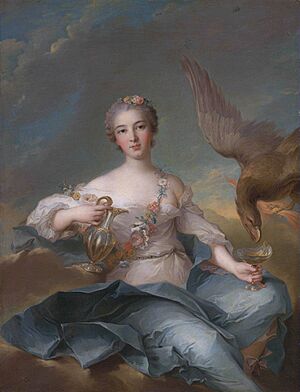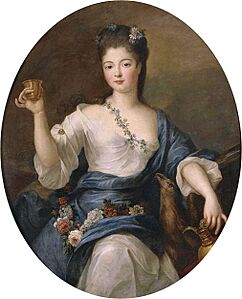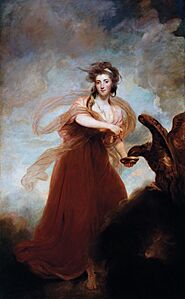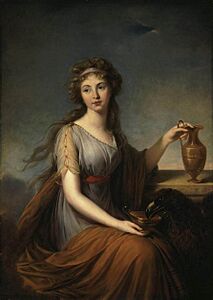Hebe facts for kids
Quick facts for kids Hebe |
|
|---|---|
|
|

Statue of the Greek goddess Hebe (Roman Juventas), by Johan Niclas Bystrom (1783-1848) at the Gripsholm Castle, Mariefred, Södermanland, Sweden.
|
|
| Abode | Mount Olympus |
| Symbol | Wine-cup, Eagle, Ivy, Fountain of Youth, and Wings |
| Personal information | |
| Consort | Heracles |
| Children | Alexiares and Anicetus |
| Parents | Zeus and Hera |
| Siblings | Ares, Hephaestus, Eileithyia and several paternal half-siblings |
| Roman equivalent | Juventas |
Hebe is the Greek goddess of youth. She was the cupbearer for the gods and goddesses of Mount Olympus, serving their nectar and ambrosia. People of Sicyon also worshipped her as the goddess of forgiveness or of mercy.
Hebe is a daughter of Zeus and Hera, and the divine wife of Heracles (Roman equivalent: Hercules). She had influence over eternal youth and the ability to restore youth to mortals, a power that appears exclusive to her.
Hebe was the youngest of the gods and the one responsible for keeping them eternally young, and thus was the most revered by them.
In art, she is typically depicted with her father in the guise of an eagle, often offering a cup to him. Eagles were connected with immortality and there was a folklore belief that the eagle (like the phoenix) had the ability to renew itself to a youthful state. Her equivalent Roman goddess is Juventas.
Contents
Etymology
The name Hebe comes from the Greek word meaning "youth" or "prime of life".
Youth
Hebe is the daughter of Zeus and his sister-wife Hera. Hebe was initially seen in myth as a diligent daughter performing domestic tasks that were typical of high ranking, unmarried girls in ancient Greece. In the Iliad, she did tasks around the household such as drawing baths for her brother Ares and helping Hera enter her chariot. Additionally, Hebe was often connected to Aphrodite, whom she was described dancing with and acting as her herald or attendant.
Marriage
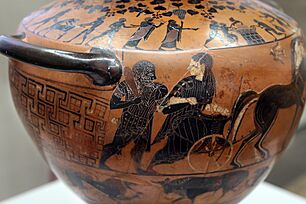
As the bride of Heracles, Hebe was strongly associated with both brides and her husband in art and literature. She was the patron of brides, due to being the daughter of the goddess of marriage Hera and the importance of her own wedding.
Hebe had two children with Heracles: Alexiares and Anicetus.
Giver of youth
One of Hebe's roles was to be the cupbearer to the gods, serving them ambrosia and nectar. In Classical sources, her departure from this role was due to her marriage. Hebe was connected to maintaining the youth and immortality of the other gods.
Cult
Hebe was particularly associated with the worship of her mother Hera in Argos and in the Heraion of Argos, one of the main centres of worship of Hera in Greece.
Hebe also had her own personal cult and at least one temple in Greece dedicated to her. There was an altar for her in Athens at the Cynosarges.
Ancient art
In art, Hebe is usually depicted wearing a sleeveless dress, typically she was depicted with either one or both her parents, at her wedding ceremony, or with Aphrodite.
Hebe was occasionally depicted with wings, which has led to confusion by modern scholars on whether depictions of winged female attendants are Hebe, Iris, or Nike.

It is possible that she is one of the winged figures from the Parthenon pediment in the British Museum, as the figure stands as an attendant to Hera and is near Zeus and Ares.
As the goddess of the brides, Hebe was often portrayed in wedding scenes.
In post-classical art
Hebe was a remarkably popular subject in art in the period from about 1750 to 1880, having attracted little artistic attention before or after. In the later period, many depictions were portraits of ladies as Hebe, for which at a minimum the only modifications to a normal costume needed were a flowing white dress, some flowers in the hair and a cup to hold. Most artists added an eagle and a setting amid the clouds.
Jean-Marc Nattier painted a Rohan princess as Hebe in 1737, and then the royal Louise Henriette of Bourbon, Duchess of Orléans (1744) and another duchess the same year as Hebe. François-Hubert Drouais painted Marie-Antoinette, when Dauphine, en Hébé in 1773, and Angelica Kauffman and Gaspare Landi both painted several Hebes. Notably, the Mercure de France addressed Marie-Antoinette as Hebe upon her marriage.
In sculpture Hebe began to flourish as a subject slightly later, but continued longer. Hubert Gerhard created an early statue of Hebe in 1590 that is currently on display at the Detroit Institute of Arts, which depicts her holding her dress in one hand and a cup raised above her head in another. She rests one foot upon a tortoise, a gesture associated with Aphrodite Urania. Antonio Canova sculpted four different versions of his statue of Hebe, and there are many later copies. This had no accompanying eagle, but including the bird was a challenge accepted by several later sculptors. An elaborate marble group with Hebe and the eagle with wings outspread was started in 1852 by the elderly François Rude but unfinished by his death in 1855. Finished by his widow and another it is now in the Musée des Beaux-Arts de Dijon and was very popular in bronze versions, with one in Chicago. Albert-Ernest Carrier-Belleuse produced another spectacular group, with the eagle perched above a sleeping Hebe (1869, now Musée d'Orsay, Paris). Jean Coulon (1853–1923) produced another group about 1886, with versions in the Musée des Beaux-Arts de Nice, Nice and the Stanford Museum in California.
Especially in America, figures of Hebe continued to be popular in the late 19th century and early 20th century for garden fountains and temperance fountains, and statues were widely available in cast stone. Tarentum, Pennsylvania, United States displays two such cast stone statues of Hebe. The mold for these statues was donated to the borough by the Tarentum Book Club on 6 June 1912. In Vicksburg, Mississippi, the Bloom Fountain installed in 1927 near the municipal rose garden, thanks to a bequest of $6,500 in the will of Louis Bloom, features a Hebe of cast zinc. At Bowling Green, Kentucky, the Hebe fountain in Fountain Square follows Canova's model, in patinated cast iron, purchased in 1881 from the J. L. Mott Iron Works of New York, at a cost of $1500. Similar Hebe fountains, probably also from Mott, are located in Court Square, Memphis, Tennessee and in Montgomery, Alabama, and one with bronze patination was formerly the Starkweather Fountain in Ypsilanti, Michigan, installed in 1889.
There is a bronze statue of Hebe, by Robert Thomas; (1966), in Birmingham city centre, England.
Gallery
-
Pierre Gobert, before 1744, Charlotte Aglaé d'Orléans, daughter of the Regent of France
-
Joshua Reynolds, 1785, Mrs. Musters as Hebe
-
Elisabeth Vigée-Lebrun, Portrait of Anna Pitt as Hebe, 1792
Genealogy
| Hebe's family tree | ||||||||||||||||||||||||||||||||||||||||||||||||||||||||||||||||||||||||||||||||||||||||||||||||||||||||||||||||||||||||||||||||||||||||||||||||||||||||||||||||||||||||||||||||||||||||||||||||||||||||||||||||||||||||||||||||||||||||||||||||||||||||||||||||||||||||||||||||||||||||||||||||||||||||||||||||||||||||||||||||||||||||||||||||||||||||||||||||||||||||||||||||||||||||||||||||||||||||||||||||||||||||||||||||||||||||||||||||||||||||||||||||||||||||||||||||||||||||||||||||||||||||||||||||||||||||||||||||||||||||||||||||||||||||||||||||||||||||||||||||||||||||
|---|---|---|---|---|---|---|---|---|---|---|---|---|---|---|---|---|---|---|---|---|---|---|---|---|---|---|---|---|---|---|---|---|---|---|---|---|---|---|---|---|---|---|---|---|---|---|---|---|---|---|---|---|---|---|---|---|---|---|---|---|---|---|---|---|---|---|---|---|---|---|---|---|---|---|---|---|---|---|---|---|---|---|---|---|---|---|---|---|---|---|---|---|---|---|---|---|---|---|---|---|---|---|---|---|---|---|---|---|---|---|---|---|---|---|---|---|---|---|---|---|---|---|---|---|---|---|---|---|---|---|---|---|---|---|---|---|---|---|---|---|---|---|---|---|---|---|---|---|---|---|---|---|---|---|---|---|---|---|---|---|---|---|---|---|---|---|---|---|---|---|---|---|---|---|---|---|---|---|---|---|---|---|---|---|---|---|---|---|---|---|---|---|---|---|---|---|---|---|---|---|---|---|---|---|---|---|---|---|---|---|---|---|---|---|---|---|---|---|---|---|---|---|---|---|---|---|---|---|---|---|---|---|---|---|---|---|---|---|---|---|---|---|---|---|---|---|---|---|---|---|---|---|---|---|---|---|---|---|---|---|---|---|---|---|---|---|---|---|---|---|---|---|---|---|---|---|---|---|---|---|---|---|---|---|---|---|---|---|---|---|---|---|---|---|---|---|---|---|---|---|---|---|---|---|---|---|---|---|---|---|---|---|---|---|---|---|---|---|---|---|---|---|---|---|---|---|---|---|---|---|---|---|---|---|---|---|---|---|---|---|---|---|---|---|---|---|---|---|---|---|---|---|---|---|---|---|---|---|---|---|---|---|---|---|---|---|---|---|---|---|---|---|---|---|---|---|---|---|---|---|---|---|---|---|---|---|---|---|---|---|---|---|---|---|---|---|---|---|---|---|---|---|---|---|---|---|---|---|---|---|---|---|---|---|---|---|---|---|---|---|---|---|---|---|---|---|---|---|---|---|---|---|---|---|---|---|---|---|---|---|---|---|---|---|---|---|---|---|---|---|---|---|---|---|---|---|---|---|---|---|---|---|---|---|---|---|---|---|---|---|---|---|---|---|---|---|---|---|---|---|---|---|---|---|---|---|---|---|---|---|---|---|---|---|---|---|---|---|---|---|---|---|---|---|---|---|---|---|---|---|---|---|---|---|---|---|---|---|---|---|---|---|---|---|---|---|---|---|---|---|---|---|---|---|---|---|---|---|---|---|---|---|---|---|---|---|---|---|---|---|---|---|---|---|---|---|---|---|---|---|---|---|---|---|---|---|---|---|
|
||||||||||||||||||||||||||||||||||||||||||||||||||||||||||||||||||||||||||||||||||||||||||||||||||||||||||||||||||||||||||||||||||||||||||||||||||||||||||||||||||||||||||||||||||||||||||||||||||||||||||||||||||||||||||||||||||||||||||||||||||||||||||||||||||||||||||||||||||||||||||||||||||||||||||||||||||||||||||||||||||||||||||||||||||||||||||||||||||||||||||||||||||||||||||||||||||||||||||||||||||||||||||||||||||||||||||||||||||||||||||||||||||||||||||||||||||||||||||||||||||||||||||||||||||||||||||||||||||||||||||||||||||||||||||||||||||||||||||||||||||||||||
See also
 In Spanish: Hebe para niños
In Spanish: Hebe para niños


